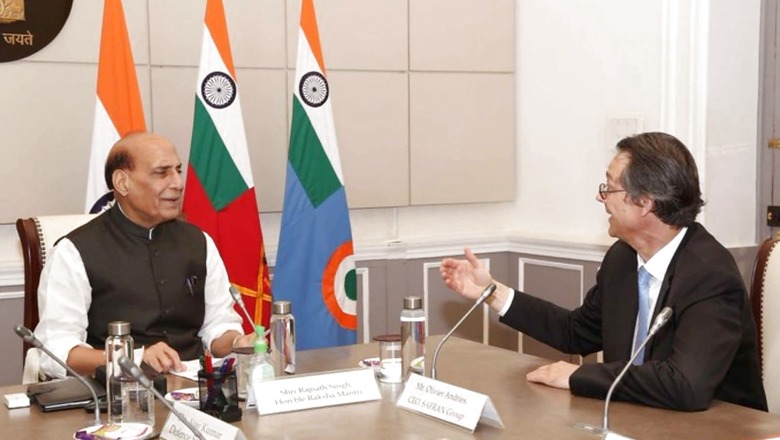
views
The meeting between Safran Group CEO Olivier Andries and Defence Minister Rajnath Singh on Tuesday marked progress towards India’s aspirations of achieving self-reliance in a key area of the defence sector.
Andries not only laid bare the French major’s plans to set up a Maintenance, Repair and Overhaul (MRO) facility in India for overhauling LEAP-1A and LEAP-1B engines for Indian and foreign commercial airlines but the meeting apparently also saw “significant progress” towards having Safran transfer the technology for making engines for India’s futuristic 6.5-generation Advanced Medium Combat Aircraft (AMCA) promised as part of Rafale offsets contracts. An indigenous combat aircraft engine has eluded India over the last several decades.
Safran is among the top original equipment manufacturers of advanced aircraft engines for civil and fighter jets. Talks between the two countries to acquire the jet engine technology have been on since 2016.
A statement released by the Defence Ministry briefly stated that Safran’s CEO outlined his company’s long-term plan in “co-development and co-production of advanced jet engines and transfer of technology as per the existing policy of Government of India”. Noting the importance India attaches to the strategic partnership with France, Rajnath Singh invited Safran for more co-development and co-production projects in India.
Safran has offered to transfer the aircraft engine technology by using offset credits available from the Rafale deal. Insiders told me that the price negotiations between the two over the transfer of technology for a 110-kN (kilo Newton) engine will continue for some more time, but Tuesday’s meeting was a pre-cursor to this and there was much “forward movement” on this front.
If the deal is sealed, this will define the biggest development towards India’s ‘Aatmanirbharta’ in the critical area of aircraft engine development. It will also once again testify India’s growing defence cooperation with France, for very few countries would agree to transfer such a critical technology to another country.
What also builds the trust is that in the past, the Safran group and Hindustan Aeronautics Limited jointly co-developed the Shakti engine, which powers India’s Dhruv and Light Combat Helicopters in use with the Army and the Indian Air Force.
Stating that Safran Helicopter Engines supplies engines to all new-generation HAL rotorcraft, Safran’s website said more than 250 units of the engine are in service at present.
Why getting aircraft engine technology will be a game-changer
India has failed to manufacture a fighter aircraft engine in the last several decades. India’s indigenous light combat jet Tejas Mark 1A is powered by the General Electric F404, while the stronger General Electric F-414 engine will power the Tejas Mark 2 version.
India is not alone. Only a handful of countries, including China, manufacture advanced aircraft engines. But even China’s aircraft engines have been plagued with quality concerns.
Aviation experts told me that France remains the top manufacturer of aircraft engines and they have demonstrated their capabilities from deserts to glaciers.
One aviation expert, who chose to remain anonymous, told me manufacturing aircraft engines is a highly specialised job and perhaps that’s the reason such few countries have been able to develop it.
“An important component of the jet engine are the turbine blades, which are subjected to extremely high temperature when the jet is taking flight. This requires those turbine blades to be of high-quality material, which can retain its shape and structure at such high temperatures,” he said.
India’s ambitious Kaveri jet engines programme also could not take off because of issues with metallurgy and complexities involved in the engines’ manufacturing. Those engines are now in the process of getting repurposed to be tested on drones. India, however, has successfully developed cryogenic rocket engines.
Steps towards self-reliance in defence
India has taken significant steps towards establishing ‘Aatmatnirbharta’ in defence. Several Acceptance of Necessity (AoNs) and contracts which were nearly finalised have been put under review to see if they can be procured indigenously instead. India has also increased its indigenous procurement target to 68 per cent of the capital budget allotted for the current financial year.
The three services are aggressively working towards self-reliance. On Tuesday, Vice Chief of Naval Staff, Vice Admiral SN Ghormade, reiterated the Navy’s commitment to Aatmanirbhar Bharat on several aspects, including that the contract for its long-pending aircraft carrier-borne fighter jets will aim at benefitting the Indian defence industry ecosystem.
The Army also has been seeking to make most purchases from Indian vendors. In the last week, the Army floated two Request for Interest (RFIs) to procure sniper rifles and light armoured multi-purpose vehicles from indigenous sources. Much of its emergency procurements in the last two years have been from indigenous vendors.
However, amid the push for ‘Aatmanirbharta’, there is no denying that the game changer would be India inking the deal to acquire aircraft engine technology to manufacture engines in the country. The achievement will set a new trajectory for India’s self-reliance in the defence journey and will brightly spotlight its success.
Read all the Latest News, Breaking News, watch Top Videos and Live TV here.

















Comments
0 comment